Excellent products and service offerings attract customers to your business, but robust customer service is still the most effective way to keep them loyal to your brand. It is also an organic route to tap into your customers’ network through positive word of mouth and referrals. In this article, we explore 10 effective customer service best practices—from optimizing your response times to incentivizing your customer service team.
Check out some of these customer support best practices you can apply to your business today.
1. Our Top Customer Service Best Practices Recommendation: Adopt Customer Service Software
Customer service software helps business owners centralize customer communications in a single platform as it utilizes an omnichannel communication approach. Using customer service software, you capture all the questions and queries from your customers and turn them into tickets. It lets you contact them through various channels, including live chat, in-app phone, social media, and email.
Freshdesk, our top pick for the best customer service software, offers multichannel communication tools, including a help desk, live chat, email, and ticketing. It has a round-robin ticketing assignment tool directing cases to readily available agents so customers’ queries are addressed promptly. In addition, Freshdesk provides agents with 360-degree customer views, including profile and historical information, and guided resolutions to increase productivity.
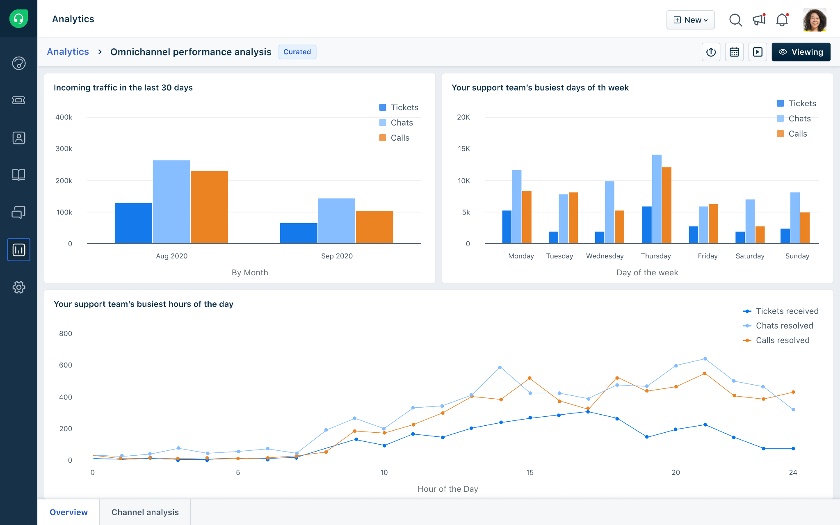
See an overall view of customer service activities (Source: Freshdesk)
2. Be Quick & Efficient in Resolving Customer Cases
As omnichannel communication has become the norm, customers expect businesses to respond to their queries quickly. Based on research conducted by HubSpot, 90% of consumers rate an “immediate response” as very important when trying to get help from a business’ customer service team.
However, speedy customer support alone is not enough. Beyond getting back to your customers as soon as possible, it’s crucial to have comprehensive customer support best practices in place.
3. Make It Easy for Customers to Find Answers on Your Website
Having a knowledge base or resource page on your website is not only beneficial to your customers, it saves your agents time from answering common questions. A knowledge base is a collection of helpful information about your products or services customers can refer to. It typically includes a page for frequently asked questions (FAQs), instructional videos on your products’ features and functionalities, and other educational resources.
Customer service software providers like Zoho Desk offer tools to help users create their own knowledge base. For example, you can draft a FAQ page including product information, pricing, refunds, returns, exchange policies, and general questions. When creating your knowledge base, there are preset categories to choose from so information is properly segmented and organized, making it easy for your customers to find answers independently.
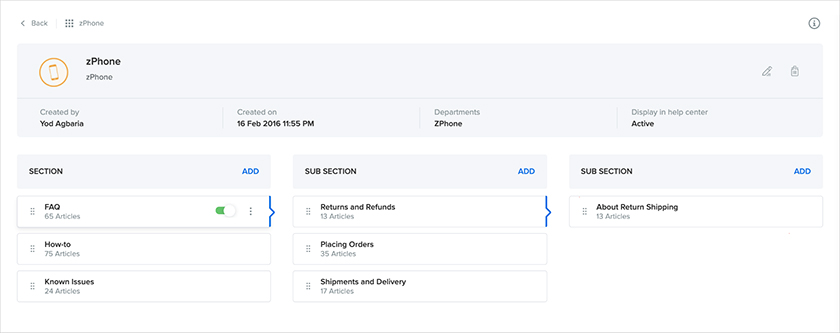
In Zoho Desk, easily create self-help guides, including a FAQ section, how-to guides, and other resource articles for common issues. (Source: Zoho Desk)
4. Send a Customer Satisfaction Survey or Feedback Form
One of the best ways to improve the quality of your customer service activities is to learn from customer service analytics via client feedback. Implement a customer satisfaction best practice, like sending surveys or forms after cases are resolved, asking them to rate their experience, and leaving comments for improvement. Satisfaction surveys can help you identify happy customers and spot unhappy customers who need nurturing.
HubSpot CRM’s Service Hub enables business owners to measure their customer satisfaction (CSAT) score by providing tools to create satisfaction surveys. Customers can answer satisfaction surveys after their case is closed, and users can send the survey through email or share a link in the live chat. The system then captures the data and provides an overall view of a business’ customer service activities over a set period.
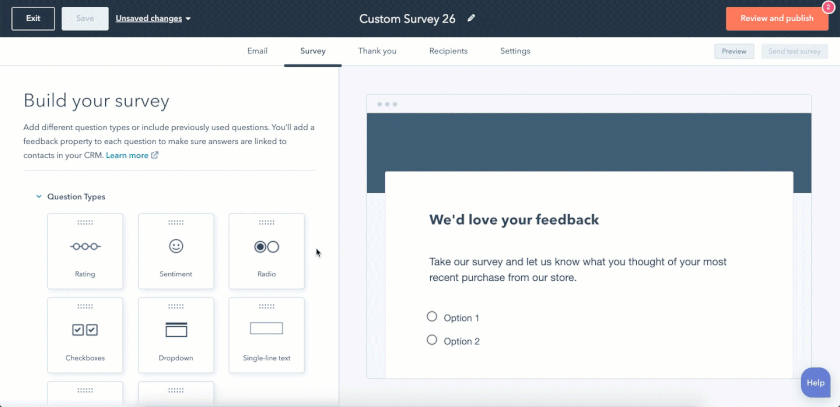
Creating a custom customer survey in HubSpot Service Hub (Source: HubSpot)
5. Record Your Customers’ Details & Offer Personalized Service
The best customer service is personalized because it makes customers feel valued. Knowing who you’re talking to by having your customers’ profile and activity history on hand is imperative to providing superior customer service.
Having a record of your customers’ past communication with your company also saves them time from repeating their concerns, especially if they have to deal with different agents within your organization. According to HubSpot, 33% of consumers find repeating their concerns to other agents one of the most frustrating aspects of getting customer service help.
Software providers like Salesforce Service Cloud capture and store all related customer information, which helps agents personalize their service to customers. Agents can easily view past purchases, conversations, and activities on a single page to know what issue they need to resolve when they talk to their customers.
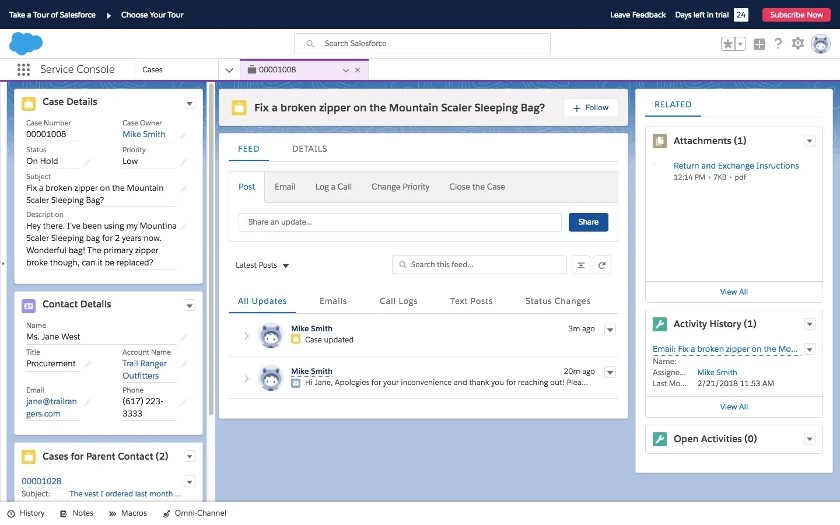
Salesforce Sales Cloud shows all customer information and interactions in one place. (Source: Salesforce)
To learn more about improving the quality of your customer service activities, check out our guide on how to measure customer service satisfaction.
6. Incentivize Your Customer Service Team
When your agents know they will be rewarded for going the extra mile to resolve a ticket as quickly and efficiently as possible, it motivates them and directly impacts the quality of support they provide to your customers.
Software providers like Freshdesk offer an agent leaderboard that shows all the agents in a customer service team. It has a gamified format that gives agents quests to unlock—from resolving a ticket to earning high customer ratings. Agents move up the leaderboard as the month progresses and see their performance against their peers, promoting healthy competition among the team.
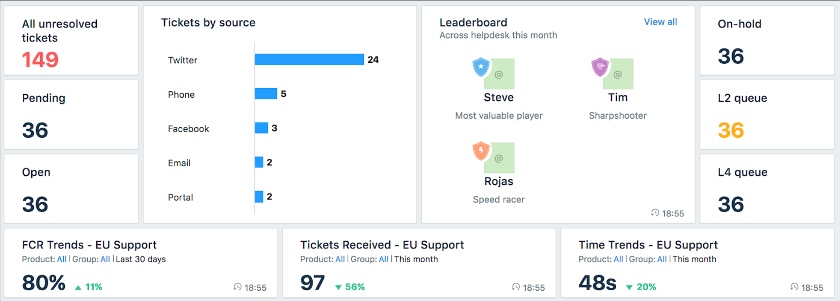
Freshdesk leaderboard showing top performers, the overall status of tickets, and customer service activities. (Source: Freshdesk)
Check out our article about sales gamification software to learn more about tools that help motivate and incentivize sales and customer service professionals.
7. Show Your Customers You Genuinely Care
When resolving customer cases, don’t treat it as a simple transaction. Instead, adopt a service-oriented mindset that encourages you to genuinely help your customers by answering their questions or addressing their concerns. Remember, your customers are the key to your business growth—hence, treat them as business partners.
For example, when I worked in B2B sales in the education sector, I treated school districts and the decision-makers (typically school administrators) as partners in creating a robust digital community for their schools. Rather than asking if they were ready to sign a new contract or renew as customers, I’d ask if they were ready to become partners in building an engaged learning community.
8. Assign a Dedicated Customer Service Team
Unless you run a micro-business that only processes a small volume of customer queries, assigning a dedicated customer service person or team within your company is a crucial customer support best practice. Doing so ensures all queries are managed promptly, and nothing falls through the cracks. Below are some of the most common members of a customer service team for small businesses:
- Customer service agents: Your customer service team’s front liner and the ones responsible for working on case resolutions
- Customer service manager: Oversees a team of agents and is typically responsible for training them; steps in when cases need to be escalated to someone on a senior level
- Technical support agents: Agents who have a more technical role such as troubleshooting or diagnosing issues
- Customer success manager: Responsible for establishing long-term relationships with customers by rolling out activities that nurture your relationship with them
- Customer experience manager: Oversees customer service touchpoints and comes up with solutions on how to improve customers’ experience every time they interact with your company
9. Deliver on Your Promises & Commit to Timelines
While it is ideal to resolve customer cases as promptly as possible, you ensure you can deliver on your committed resolution or next step of action. For example, if you promised a refund to a customer and transfer back the money in two working days, make sure you do so.
Always remember to make a commitment you’re confident you can deliver, and don’t make promises you know you can’t keep just to appease a disgruntled customer. It’s always better to over-deliver and surpass your client’s expectations than not follow through with something you previously promised.
10. Conduct a Follow-up Check With Customers
While following up with a customer after resolving a case is not always possible for all cases, it is ideal when offering a high-value service and having a smaller customer pool. For example, check in with a client after a week to see if they are still having problems with their product after having it repaired.
While a simple call only takes a few minutes, it shows the client you’re genuinely concerned about resolving their issue and ensuring they are satisfied. Customers remember this action when someone in their network asks for a referral. Plus, it helps keep your clients loyal because they know they will be cared for.
Bottom Line
Providing an excellent customer service experience is a no-fail strategy to increase your customer retention rate. The best customer service practices improve the overall customer experience and help you commit to feasible timing. Remember, it is easier to retain a customer than to find a new one, so take care of the ones in your existing customer pool by observing these customer support best practices.